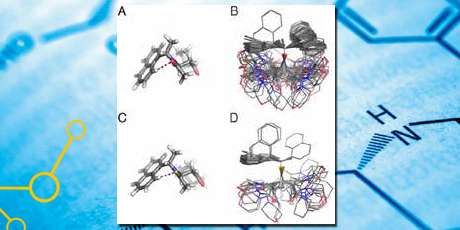
Synthesis of Peptide-mimicking Compounds
Based on natural protein folding principles, a number of bio-mimetic compounds with drug application relevance have been synthesized.
Peptides and proteins are highly active and selective biological molecules. Just as these properties are vital to all functions in the body, they are also highly sought after in pharmaceutical agents. For more than a century it has been known that it is possible to design and synthesize artificial compounds based on the same folding principles, which apply to natural proteins. For many years, though, such molecules were thought to have only scientific interest. It was considered that production costs would be too high, and the level of degradation of these compounds too high in the body for them to be realistic drug candidates. This view is changing in the pharmaceutical industry with the arrival of the first so-called recombinant protein therapies. It is realized that the unnatural origin of certain bio-mimetic substances can actually be an advantage in drug applications, since they may exhibit improved stability towards enzymatic degradation.
Jonas S. Laursen’s thesis presents design, synthesis, and characterization of a number of such biomimetic compounds with biomedical relevance.
Proteins are large molecules built from amino acids, which are connected by amide bond linkages, or peptide bonds. By varying the positioning of the total 20 amino acids available, the proteins constitute highly diverse class of molecules. Further, the proteins realize their diversity by folding the backbone into a well-defined three-dimensional structure, which is encoded by the sequence of amino acids. Artificial compounds with a similar ability to fold have been coined “foldamers”.
This project focuses on the folding propensities of β-peptoids, a combination of two peptidomimetic foldamers, the β-peptides and peptoids. While β-peptoids have already found use in biologically active compounds, their folding propensity has been sparsely studied. In the project the effect of structural variations, including side chain substitution, introduction of thioamides, and trifluoroacetylation, on the cis-trans amide bond rotamer equilibria in monomer model systems was studied. The latter systems revealed an increase in the preference for cis-amides as compared to their parent compounds and thus provide novel strategies for affecting the folding of peptoid constructs. Evidence was found for the presence of thioamide-aromatic interactions through Csp2-H∙∙∙Samide hydrogen bonding.
A β-peptoid oligomer was designed from residues prone to fit a helical arrangement found by density functional theory (DFT) calculations. X-ray crystal structures for two hexameric compounds respectively with a free N-terminal amine and with an N-terminal acetyl group were solved in collaboration with Associate Professor Pernille Harris at DTU Chemistry. These are the first examples of high-resolution structures of linear β-peptoid oligomers, and clearly show that these compounds form unique helical arrangements.
In conclusion, the project underlines that the β-peptoids should be considered a valid addition to the already existing ensemble of foldamer designs.
Caption: Calculated structures of compounds 6e (A and B) and 12e (C and D). All structures within 21 kJ × mol−1 of the global minimum were superimposed.